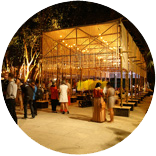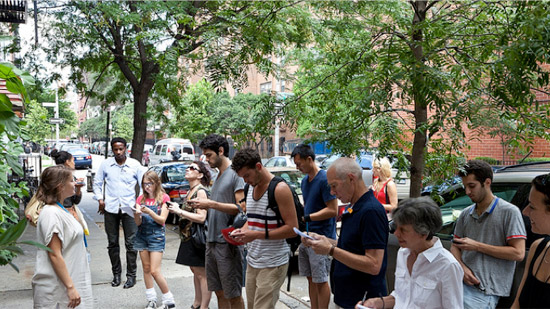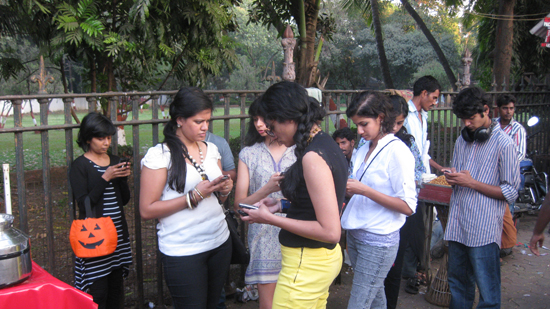Testing, Testing!
It’s possible to think of a city, and the life that it contains, as a vastly complicated network of human interactions—between individuals, groups, and the physical layout and appearance of city spaces and the people who occupy them. The nature of those interactions, and the manner in which they are influenced by urban design, constitutes the heartbeat of urban life. Psychologists have used a wide variety of different approaches to try to deconstruct these complicated relationships, but most of them have been based in laboratory studies: people are shown pictures of city scenes, and psychologists measure their reactions to those images. These kinds of laboratory-based studies have yielded some important insights into how the environment affects human behavior, but one important element is missing from these well-controlled simulations of city life: they’re not real.
In Testing, Testing!, an experiment developed by research psychologist Colin Ellard and New York Lab Team member Charles Montgomery, and conducted by Ellard in the BMW Guggenheim Lab’s three locations to date—New York, Berlin, and Mumbai—the goal was to take such studies out of the laboratory and onto the streets. By inviting participants to walk through the urban terrain, and measuring the effects of environment on their bodies and minds, Ellard aimed to collect data in real, living urban environments. That data would then be available for application within urban planning and design to enhance urban comfort, increase functionality, and keep city dwellers’ stress to acceptable levels.
In each city, Ellard created short walking tours of the urban environment, selecting a series of sites, based on theory in environmental psychology; on urgent, site-specific issues of the city under study; and on simple curiosity. For each chapter of the experiment, he consulted with local people and organizations to get some sense of the kinds of contrasts that might be most effectively studied, and where his findings might be of most use. Participants were fitted with sensors that measured skin conductance, and smartphones that allowed them to record their responses to questions given at each of the stopping points (or paper-and-pencil analogs of the smartphone tasks). In addition to the self-report data collected using the smartphones, Ellard also used specialized biosensors that allowed him to measure a participant’s excitement, interest, and levels of stress.
Based on the collected data, Ellard was able to map body variables as a function of location in the city. In the slideshow above is a map of the full walking route used in the 2011 experiments in New York, with an overlaid “stress contour” where the height of the contour shows levels of stress.
Key findings from Testing, Testing! include the following:
• Open facades with many doorways, window displays, and activity had the most appeal, especially for participants in New York and Berlin, who much preferred them over more anonymous, super-block facades.
• In keeping with Ellard’s predictions, green spaces were the sites where people were in the most positive states of mind. There was an interesting distinction between the sites visited, however: in the community garden Ellard’s tour visited in New York, this positive state was accompanied by a low level of excitement, whereas in both a Berlin cemetery and a Mumbai hospital garden, levels of excitement were higher. Ellard speculates that this difference might have come about, in part, because of the differences in the meanings of the two sites. A cemetery, by virtue of its appearance, might be psychologically restorative, but it might cause a heightened level of mental activity due to an increase in feelings of mortality. Similarly, the hospital garden, though replete with trees and plants, would have been easily identified as a place of convalescence.
• The study suggests that city dwellers are not very good at self-monitoring bodily states while walking city streets. This may have implications regarding health in cities: because some of the factors that contribute to urban stress (urban density and crowding, for example) are likely to increase, city dwellers might best be able to inoculate themselves against the effects of urban stress by understanding, recognizing, and regulating levels of personal stress by means of strategic use of urban space.
Findings such as these have relevance in a range of contexts: they can be applied on the individual level, bringing attention to city dwellers’ personal experience of their environment, and can also be brought to bear on urban planning. Additionally, the methodology of Testing, Testing! has the potential to be replicated in other cities and through other frameworks, contributing an important and useful new means of measuring, in real environments, the true impact of cities on people.
To learn more about the Testing, Testing! project, download an illustrated overview here [PDF 11.4 MB].





